
Weird But Healthy Food
Posted on 20 Nov, 2021
 If you find yourself falling into a boring food rut meal after meal, we’re here to dig you out. Mix things up with these ridiculously nutritious antidotes to culinary boredom. Yes, the foods listed here may appear odd, but we have faith that you can learn to love these strange but healthy foods.
If you find yourself falling into a boring food rut meal after meal, we’re here to dig you out. Mix things up with these ridiculously nutritious antidotes to culinary boredom. Yes, the foods listed here may appear odd, but we have faith that you can learn to love these strange but healthy foods.
 Ancient cultures depended on amaranth as a major staple of their diet, due to its high concentration of protein, minerals, and vitamins. It has since been exported to other parts of the world, including Europe and North America, but it is still primarily grown and consumed in Central America.
Ancient cultures depended on amaranth as a major staple of their diet, due to its high concentration of protein, minerals, and vitamins. It has since been exported to other parts of the world, including Europe and North America, but it is still primarily grown and consumed in Central America.
Although many varieties of amaranth are considered a weed, there are some varieties in the genus that are cultivated as leafy vegetables and types of cereal grain.
As a grain, it has higher fiber content than wheat, Amaranth also provides potassium, Vitamins A and C, and iron. It’s easy on the digestive system so it’s popular amongst those recovering from sickness.
Kohlrabi
 A cousin of cabbage and broccoli, this funny looking veggie looks like a turnip and is often a light green or purple color with white stripes. Great in salads or stir-fries, Kohlrabi has lots of potassium, cancer-fighting phytochemicals, and vitamin C (one cup packs 138% of your daily allotment).
A cousin of cabbage and broccoli, this funny looking veggie looks like a turnip and is often a light green or purple color with white stripes. Great in salads or stir-fries, Kohlrabi has lots of potassium, cancer-fighting phytochemicals, and vitamin C (one cup packs 138% of your daily allotment).
Seabuckthorn
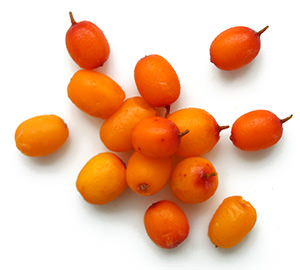 Sea buckthorn is one of the coolest, weirdest fruits around. The acidic berries are a key component of traditional Chinese medicine and boast high levels of healthy fats, particularly the rare omega-7. Plus, with about 15 times the vitamin C of oranges, lots of vitamin E, and tons of amino acids, they definitely achieve superfood status. Sea buckthorn does double duty as a powerful beautifier, and the oily berries are often featured in skin products.
Sea buckthorn is one of the coolest, weirdest fruits around. The acidic berries are a key component of traditional Chinese medicine and boast high levels of healthy fats, particularly the rare omega-7. Plus, with about 15 times the vitamin C of oranges, lots of vitamin E, and tons of amino acids, they definitely achieve superfood status. Sea buckthorn does double duty as a powerful beautifier, and the oily berries are often featured in skin products.
Kelp
 Venture underwater for your dinner, and you’ll surface with a whole bunch of new nutrients you can’t get on land. Sea vegetables provide an array of unique minerals, like iodine and underwater antioxidants. Kelp, a type of brown algae that’s a lot more delicious than it sounds, is full of iron, folate, and vitamin K. It’s anti-inflammatory and might help lower cholesterol.
Venture underwater for your dinner, and you’ll surface with a whole bunch of new nutrients you can’t get on land. Sea vegetables provide an array of unique minerals, like iodine and underwater antioxidants. Kelp, a type of brown algae that’s a lot more delicious than it sounds, is full of iron, folate, and vitamin K. It’s anti-inflammatory and might help lower cholesterol.
Romanesco
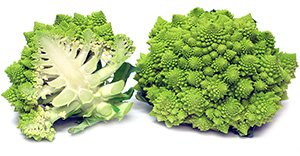 Insanely delicious and a geometric wonder? Your plate has never been prettier. Romanesco looks and cooks like cauliflower, with a light broccoli flavor and loads of vitamin C, vitamin K, and—of course—antioxidants.
Insanely delicious and a geometric wonder? Your plate has never been prettier. Romanesco looks and cooks like cauliflower, with a light broccoli flavor and loads of vitamin C, vitamin K, and—of course—antioxidants.
And here’s why it’s the coolest crucifer ever: count the spirals per head, and it’s always a Fibonacci number. All hail the vegetable fractal!
Cherimoya
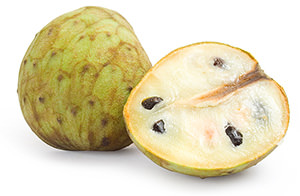 Originating from the Andean valley in South America, Cherimoya is a great source of vitamin C, B-complex vitamins, and numerous other important minerals and nutrients from copper and iron to magnesium and manganese. The fruit also contains a good amount of fiber, which helps protect your colon against toxic substances and the absorption of bad cholesterol.
Originating from the Andean valley in South America, Cherimoya is a great source of vitamin C, B-complex vitamins, and numerous other important minerals and nutrients from copper and iron to magnesium and manganese. The fruit also contains a good amount of fiber, which helps protect your colon against toxic substances and the absorption of bad cholesterol.
Kiwano
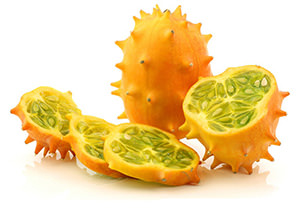 Kiwano or the “horned melon” hails from the Kalahari desert region of central Africa and has origins in Botswana, South Africa, Namibia, Zimbabwe, Malawi, and Nigeria. This spiky yellow fruit is rich in vitamin A, vitamin C, iron and potassium and contains smaller amounts of phosphorus, magnesium, zinc, calcium, and copper. Its seeds are packed with linoleic acid and olei acid, which helps lower blood pressure.
Kiwano or the “horned melon” hails from the Kalahari desert region of central Africa and has origins in Botswana, South Africa, Namibia, Zimbabwe, Malawi, and Nigeria. This spiky yellow fruit is rich in vitamin A, vitamin C, iron and potassium and contains smaller amounts of phosphorus, magnesium, zinc, calcium, and copper. Its seeds are packed with linoleic acid and olei acid, which helps lower blood pressure.
Dragonfruit
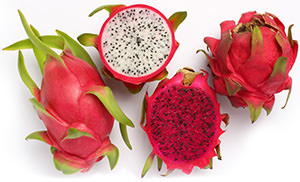 Dragonfruit is high in protein, has high fiber content contains bone-strengthening calcium. Nutrients like vitamin C, thiamine (vitamin B1) riboflavin (vitamin B2), niacin (vitamin B3) carotene, phosphorus, andiron are also found in dragonfruit.
Dragonfruit is high in protein, has high fiber content contains bone-strengthening calcium. Nutrients like vitamin C, thiamine (vitamin B1) riboflavin (vitamin B2), niacin (vitamin B3) carotene, phosphorus, andiron are also found in dragonfruit.
Dragonfruit also contains phytoalbumins, antioxidants which prevent cancer cell formation, and lycopene, which has been proven to safeguard against prostate cancer.
Books On Healthy Eating We Like

by John Berardi


by Dr. Alejandro Junger

by Robin Jeep

 Fermented Foods And Why They Are So Good For You
Fermented Foods And Why They Are So Good For You 8 Great Ways To Prepare Eggs
8 Great Ways To Prepare Eggs The 9 Safest Seafood Options
The 9 Safest Seafood Options The 9 Worst Breakfasts For Your Waistline
The 9 Worst Breakfasts For Your Waistline










